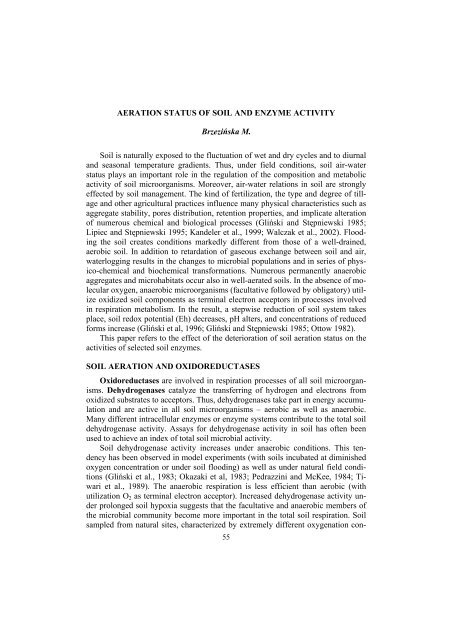soil - Lublin
soil - Lublin
soil - Lublin
You also want an ePaper? Increase the reach of your titles
YUMPU automatically turns print PDFs into web optimized ePapers that Google loves.
AERATION STATUS OF SOIL AND ENZYME ACTIVITY<br />
Brzezińska M.<br />
Soil is naturally exposed to the fluctuation of wet and dry cycles and to diurnal<br />
and seasonal temperature gradients. Thus, under field conditions, <strong>soil</strong> air-water<br />
status plays an important role in the regulation of the composition and metabolic<br />
activity of <strong>soil</strong> microorganisms. Moreover, air-water relations in <strong>soil</strong> are strongly<br />
effected by <strong>soil</strong> management. The kind of fertilization, the type and degree of tillage<br />
and other agricultural practices influence many physical characteristics such as<br />
aggregate stability, pores distribution, retention properties, and implicate alteration<br />
of numerous chemical and biological processes (Gliński and Stępniewski 1985;<br />
Lipiec and Stępniewski 1995; Kandeler et al., 1999; Walczak et al., 2002). Flooding<br />
the <strong>soil</strong> creates conditions markedly different from those of a well-drained,<br />
aerobic <strong>soil</strong>. In addition to retardation of gaseous exchange between <strong>soil</strong> and air,<br />
waterlogging results in the changes to microbial populations and in series of physico-chemical<br />
and biochemical transformations. Numerous permanently anaerobic<br />
aggregates and microhabitats occur also in well-aerated <strong>soil</strong>s. In the absence of molecular<br />
oxygen, anaerobic microorganisms (facultative followed by obligatory) utilize<br />
oxidized <strong>soil</strong> components as terminal electron acceptors in processes involved<br />
in respiration metabolism. In the result, a stepwise reduction of <strong>soil</strong> system takes<br />
place, <strong>soil</strong> redox potential (Eh) decreases, pH alters, and concentrations of reduced<br />
forms increase (Gliński et al, 1996; Gliński and Stępniewski 1985; Ottow 1982).<br />
This paper refers to the effect of the deterioration of <strong>soil</strong> aeration status on the<br />
activities of selected <strong>soil</strong> enzymes.<br />
SOIL AERATION AND OXIDOREDUCTASES<br />
Oxidoreductases are involved in respiration processes of all <strong>soil</strong> microorganisms.<br />
Dehydrogenases catalyze the transferring of hydrogen and electrons from<br />
oxidized substrates to acceptors. Thus, dehydrogenases take part in energy accumulation<br />
and are active in all <strong>soil</strong> microorganisms – aerobic as well as anaerobic.<br />
Many different intracellular enzymes or enzyme systems contribute to the total <strong>soil</strong><br />
dehydrogenase activity. Assays for dehydrogenase activity in <strong>soil</strong> has often been<br />
used to achieve an index of total <strong>soil</strong> microbial activity.<br />
Soil dehydrogenase activity increases under anaerobic conditions. This tendency<br />
has been observed in model experiments (with <strong>soil</strong>s incubated at diminished<br />
oxygen concentration or under <strong>soil</strong> flooding) as well as under natural field conditions<br />
(Gliński et al., 1983; Okazaki et al, 1983; Pedrazzini and McKee, 1984; Tiwari<br />
et al., 1989). The anaerobic respiration is less efficient than aerobic (with<br />
utilization O 2 as terminal electron acceptor). Increased dehydrogenase activity under<br />
prolonged <strong>soil</strong> hypoxia suggests that the facultative and anaerobic members of<br />
the microbial community become more important in the total <strong>soil</strong> respiration. Soil<br />
sampled from natural sites, characterized by extremely different oxygenation con-<br />
55

















